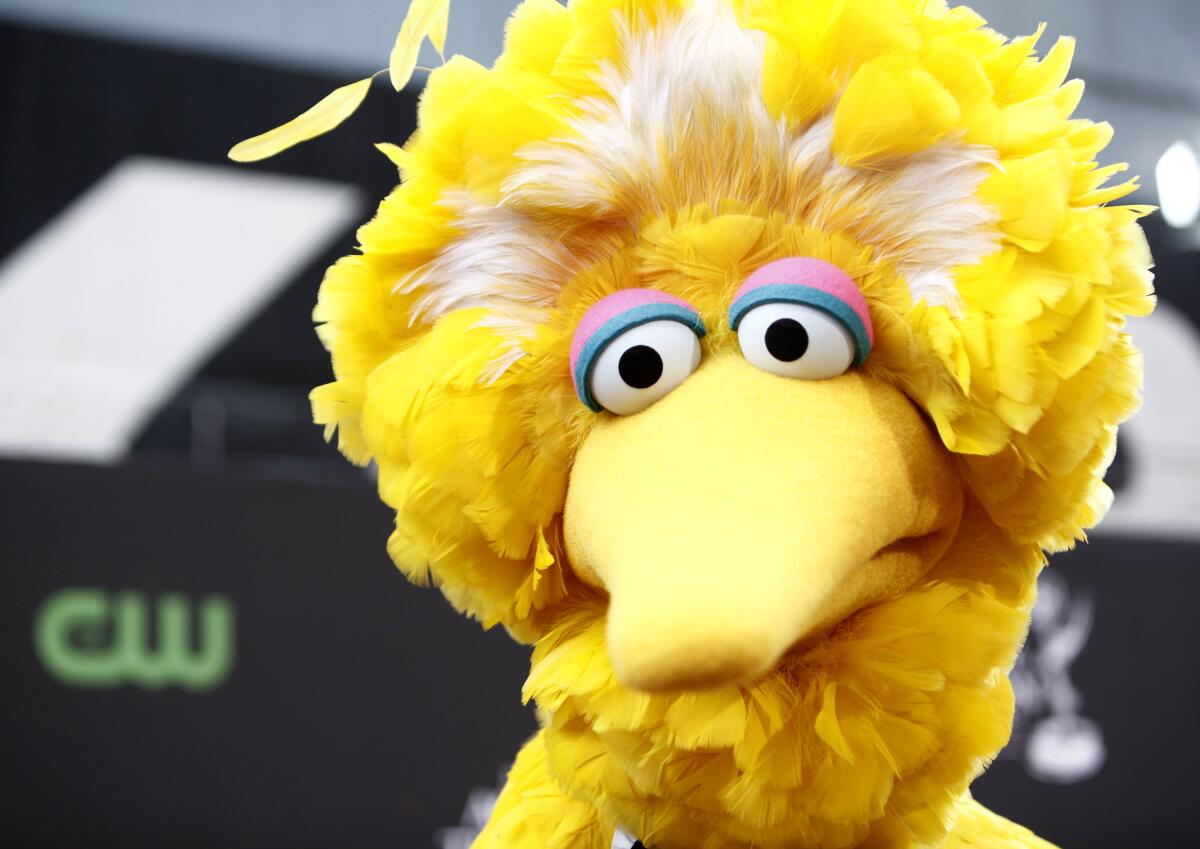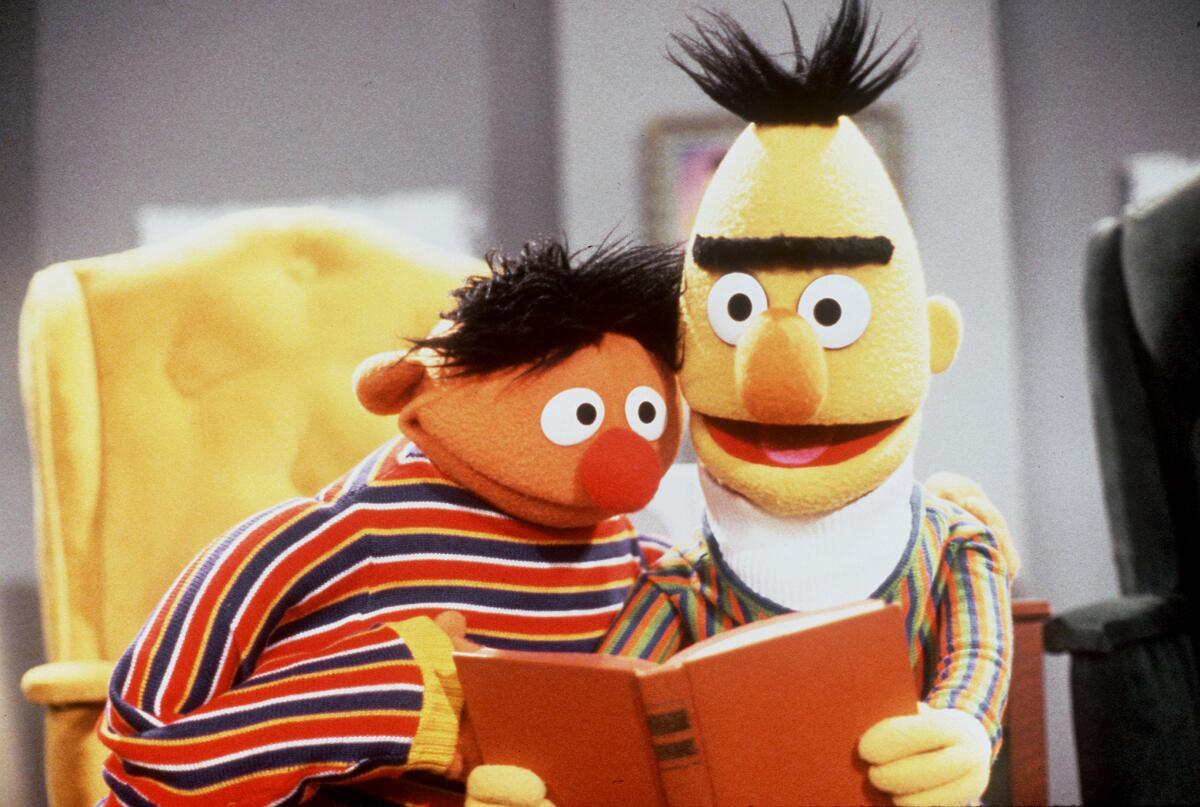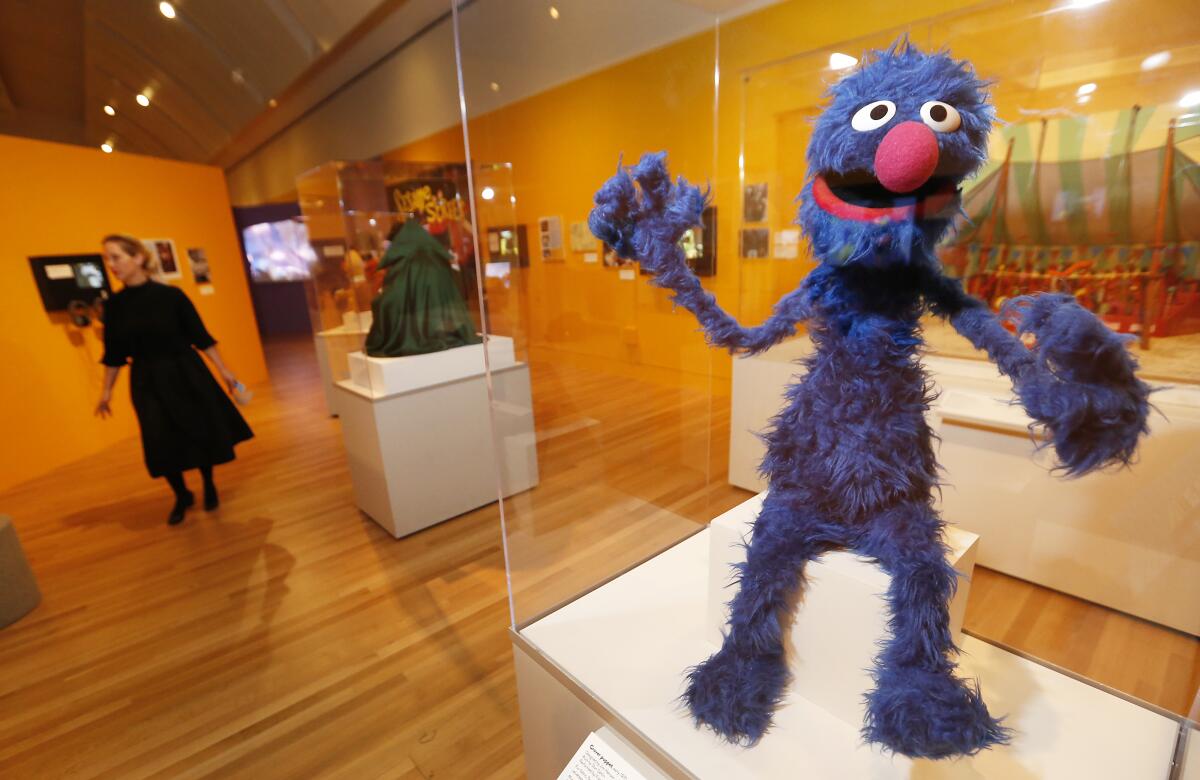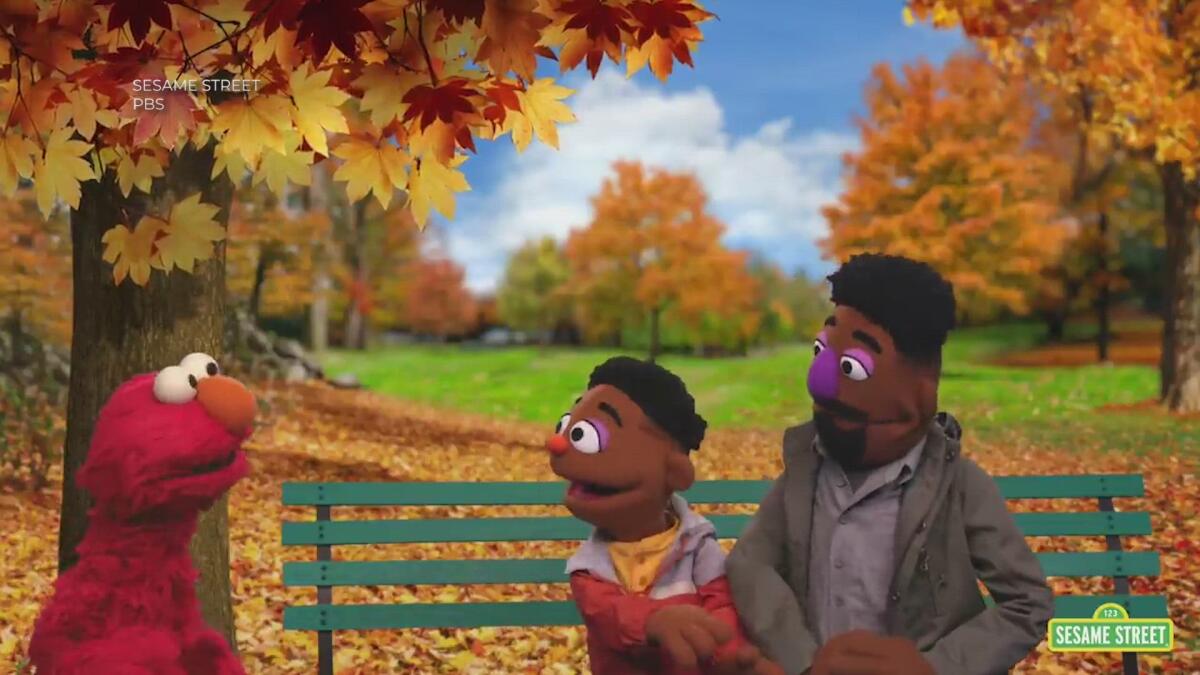Column: How ‘Sesame Street’ can prepare kids for climate disasters

- Share via
Twenty-three years ago, “Sesame Street” aired a remarkable series of episodes during which the iconic puppets and their human friends must recover from a hurricane. One focus is Big Bird’s struggle to come to terms with the destruction of his nest.
“I’m angry at that hurricane for wrecking my home,” he tells his companions. “I feel sad.”
PBS re-aired versions of the episodes after Hurricane Charley struck Florida in 2004, and again after Hurricane Katrina devastated New Orleans a year later, and again after Hurricane Sandy slammed the Northeast. The latest rerun began with longtime “Sesame Street” resident Gordon Robinson (Roscoe Orman) offering a word of guidance to parents and other caregivers.
“Every year, there are a number of natural disasters that affect many people. Even if you are not directly affected, the television coverage of these events can be scary, especially to young children,” he said. “Several years ago, we featured a weeklong story about a hurricane on ‘Sesame Street.’ This storyline allowed us to provide children with strategies to help them cope with their emotions when faced with a natural disaster. So watch with your child and talk about any fears or concerns he or she might have.”
You're reading Boiling Point
Sammy Roth gets you up to speed on climate change, energy and the environment. Sign up to get it in your inbox twice a week.
You may occasionally receive promotional content from the Los Angeles Times.
From there, the show launched into its hopeful, happy-go-lucky theme song:
“Sunny day
Sweepin’ the clouds away
On my way to where the air is sweet
Can you tell me how to get
How to get to Sesame Street?”
Discordant? Maybe a little.
But also poignant — and hopefully a sign of powerful stories to come, as Big Bird and friends tackle the climate crisis.
As financiers and industry titans sounded off at the Milken Institute Global Conference in Beverly Hills this month — ExxonMobil Chief Executive Darren Woods served up misleading views on climate, while Tesla’s Elon Musk warned about artificial intelligence leading to the destruction of civilization — the people behind “Sesame Street” offered a decidedly humbler announcement.
Sesame Workshop — the New York nonprofit that’s been producing the show for 55 years — said it would partner with the global charity Save the Children to “foster young children’s climate resilience.” Basically, the organizations intend to work together to tell stories — starring Elmo, Cookie Monster, Grover and company — that will help kids and their families prepare for the increasingly extreme storms, floods, droughts and other weather extremes already being worsened by coal, oil and gas pollution.
Sherrie Westin, president of Sesame Workshop, said one goal is emotional well-being — helping kids learn to cope with an issue they’ll deal with their whole lives, even if we quickly phase out fossil fuels and avoid far more dangerous consequences.
“We know how important it is to reach children in those critical early years. It’s when their brain is developing faster than at any other time,” Westin said at a Milken conference panel led by Willow Bay, dean of USC’s Annenberg School for Communication and Journalism. “We’re talking about giving [children] tools at an early age, helping them develop problem-solving, give them a sense of agency, so that they can feel empowered to take care of themselves, their communities.”

“Sesame Street” has always been part entertainment, part education, with lessons running the gamut from the alphabet to racial tolerance — typically backed up by rigorous research. The show hasn’t shied away from environmental stories in the past.
But although the venture into climate programming is new, it’s hardly out of step with the rest of the entertainment industry.
Last month, the Walt Disney Co. promised to replace the gas-guzzling ride vehicles at Disneyland’s Autopia attraction with electric cars, after a pressure campaign by climate activists. A year earlier, NBCUniversal launched its GreenerLight Program, with a goal of incorporating sustainability themes in films released by Universal Pictures, Focus Features and DreamWorks Animation.
Our world is changing fast. It makes sense that the “Sesame” creators want to help children learn to live in that world.
So what might that look like in practice?
Intrigued by the Milken panel — which featured a guest appearance by Grover! — I reached out to Sesame Workshop and Save the Children. Although many details are still being worked out, Save the Children’s president, Janti Soeripto, told me some of the programming will be extremely direct. For instance, the organizations hope to teach kids in developing countries in particular — in refugee camps, for instance — where to go when a hurricane or a flood hits, and how to keep their families safe.
They’ll make sure kids know about climate solutions, too.
One example: “for children in Sierra Leone [to learn] that the mangrove forest plays a really important role in carbon capture, for the world ... and what they can do to help preserve it, without making their community lose their livelihoods,” Soeripto said.
“Every single country or region will have its own climate and natural issues that children need to learn,” she added.
Introducing kids to climate solutions — and teaching them how to safeguard themselves and their loved ones from disasters it’s too late to avoid — will hopefully help them grapple with a growing sense of despair that’s prevalent among young people.
“Climate anxiety is real,” Westin said.
“And it’s here now. It’s not just in the future,” Soeripto said.

Global warming is overwhelming, as Grover noted during his Milken conference cameo. As much as people love “Sesame Street,” can a single TV show really prepare millions of children around the world for supercharged storms, floods and fires?
There’s academic research suggesting that maybe it can.
In 2019, economists Melissa Kearney and Phillip Levine co-authored a peer-reviewed study finding that preschool-age kids who had access to “Sesame Street” when it first aired in 1969 did better in school than those who didn’t — with long-lasting effects. They determined that students who lived in parts of the U.S. where they were able to see the initial broadcasts were 14% more likely to be attending the age-appropriate grade years later, in middle school and high school.
That doesn’t mean “Sesame Street” will be a climate game-changer in the 2020s — especially with far more shows and games for today’s kids to choose from. It’s a different world from the one in which ABC, CBS, NBC and PBS were the main options.
Still, Levine — a professor at Wellesley College — suspects Elmo and his pals can help bend the climate narrative a bit.
“There’s very good evidence on the immediate impact of watching the show,” he said.
Marie-Louise Mares, a professor of communication arts at University of Wisconsin-Madison, feels similarly.
In 2013, she and her colleague Zhongdang Pan conducted a peer-reviewed analysis of two dozen existing studies exploring how “Sesame Street” had affected the education of more than 10,000 children around the world. Their analysis was commissioned by Sesame Workshop, as were some of the studies they examined. But the nonprofit stayed out of the research, Mares told me.
There were a few areas where “Sesame Street” didn’t seem to have much influence on early childhood learning, she said. But on the whole, the show had many positive effects, including better literacy, numeracy and health and safety knowledge.
As for climate change, “it definitely makes sense to me that ‘Sesame Street’ could be effective,” she said.
For that to happen, though, Sesame Workshop and Save the Children will need some money.
They’re trying to raise $500,000 — not that much in the grand scheme of global philanthropy — to launch a pilot in Bangladesh, where Sesame Workshop has been co-producing the show “Sisimpur” for nearly two decades, and where extreme temperatures, one of the deadliest consequences of fossil fuel combustion, have recently kept tens of millions of kids home from school.
The nonprofits will try to share “Sesame Street” stories with families that don’t have television sets or even electricity — perhaps by following a model that Sesame Workshop utilized during the Syrian refugee crisis, which involved trained facilitators delivering Arabic-language “Ahlan Simsim” programming to schoolchildren through WhatsApp group calls. New York University researchers found that the WhatsApp calls were remarkably beneficial for language, numeracy and social-emotional development skills.

Eventually, Sesame Workshop and Save the Children hope to raise $5 million to expand the initiative to the U.S. and elsewhere.
“We also have a lot of data that shows that even though you’re creating content that’s essentially for a child, it becomes a catalyst for adult behavior change,” Westin said. “It’s one of the very few children’s properties that also appeals to adults.”
I don’t have strong recollections of watching “Sesame Street” as a toddler, but my mom tells me that I absolutely adored Elmo — “Emmo” was one of my first words — and that I must have learned a lot. She said I was walking around a social hall a few months after my first birthday when I spotted a trash can and excitedly blurted out, “Ocka!” — a reference to Oscar the Grouch.
Watching the hurricane episodes, I’m sad to say I didn’t feel much nostalgia. But I understood what Westin meant about the cross-generational appeal. I chuckled at a few in-jokes, and at a silly storyline involving an overly zealous building inspector.
I also had no trouble imagining how “Sesame Street” could be put to good use for climate purposes.
The hurricane episodes didn’t mention the climate crisis explicitly. But they did feature the key elements the show will need as its writers, producers, actors and puppeteers begin to confront these topics — a character coping with climate anxiety (Big Bird) and a resilience of spirit that leaves viewers feeling hopeful there’s a light at the end of the tunnel, even when it’s hard to see.
As Gordon counsels his grief-stricken friend, “You’re right, Big Bird, it’s not alright. But it will be alright.”
The storyline concludes with the “Sesame Street” crew helping Big Bird rebuild his nest. Everything is OK. A happy ending.
With global warming, the conclusions won’t be so simple. I wonder how the show will navigate that treacherous terrain.
However it works out, I’m glad Elmo and Oscar are going to try.
“Come and play
Everything’s A-OK
Friendly neighbors there
That’s where we meet
Can you tell me how to get
How to get to Sesame Street?”
This column is the latest edition of Boiling Point, an email newsletter about climate change and the environment in California and the American West. You can sign up for Boiling Point here. And for more climate and environment news, follow @Sammy_Roth on X.
Toward a more sustainable California
Get Boiling Point, our newsletter exploring climate change, energy and the environment, and become part of the conversation — and the solution.
You may occasionally receive promotional content from the Los Angeles Times.




